
Alliance Images/Shutterstock
Thanks to the rise of technology and social media, modern society is highly visual, with photos making up the majority of social sharing. Your device’s camera reel tells more about your life, hometown, hobbies, friends, and family than an autobiography could.
Yet the nature of digital images complicates things, as does the prevalence of image dumps on Facebook and Instagram. It turns out that with every photo you snap, you risk revealing your private data to the world and, in a worst-case scenario, hackers and other criminals. In some cases, you don’t even have to share an image for it to be a security risk.
Keeping your digital photos safe goes beyond setting a passcode on your smartphone or declining friend requests from unknowns on Facebook. Before you capture that beautiful sunset or document your Instagram-worthy meal for posterity, consider how you can keep your digital photos safe in 2024.
Understand your image EXIF data
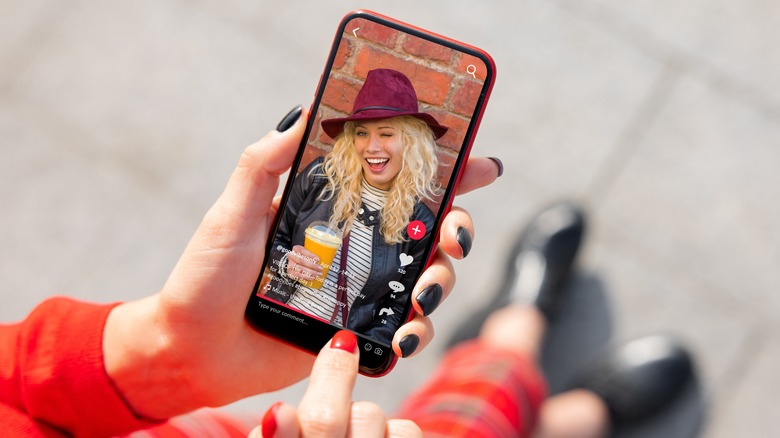
Kaspars Grinvalds/Shutterstock
Each photo you take collects more than a memory; smartphones and cameras store tons of data with each snap. Even if your photos are only for personal use, every image contains EXIF (Exchangeable Image File Format) data.
EXIF data includes information like photograph location, a time and date stamp, device information, and camera settings. Wherever that image goes — whether you post it on social media, text it to a friend, or upload it to the cloud — the EXIF data goes, too.
Another complicating factor? Many social media sites keep the EXIF info on purpose. Facebook, for example, may use EXIF information to customize your experience. Sites like Flickr give users control over their EXIF info, and various others (including Facebook, Instagram, Twitter, and WhatsApp) hide the data from other users, but it’s unclear how the sites themselves may use it.
If prevention is the goal, versus relying on apps to scrub the data for you, learn how to access your photos’ metadata and explore your device settings. Turning off the camera’s location feature (under Location Services on iOS and under Camera on Android) is the first step in keeping you and your images safe. Another simple fix is to use Google Photos or Apple Photos to share images and select the option to do so without EXIF data.
Maintain a reliable photo backup

Nicoelnino/Getty Images
If you have ever taken your phone for an accidental swim or had it slip out of your grasp over concrete, you already understand the importance of off-device storage. Even with digital SIM cards and recovery processes, photographs are not the kind of data most smartphone users want to risk losing.
When it comes to photo safety for your image library, a reliable backup is the best way to secure your photos. Many devices feature automatic syncing services to back your camera reel up in the cloud. If you have that option, it’s worth using. However, there are also perks to choosing an external backup.
An external hard drive, memory card, or USB drive allows you to make a portable copy of your photo library. Encryption — aka password protection — is another layer of security that keeps your data secure, but password protection may not be necessary if you keep your hard drive in a secure place.
With cloud storage, your service provider handles the encryption and security. Despite stories of hackers leaking personal information, cloud service providers have a legal responsibility to provide cloud security and defend your data against threats. For the most peace of mind, you may consider both hard copy and cloud backups to keep your photos safe.
Deter would-be image thieves
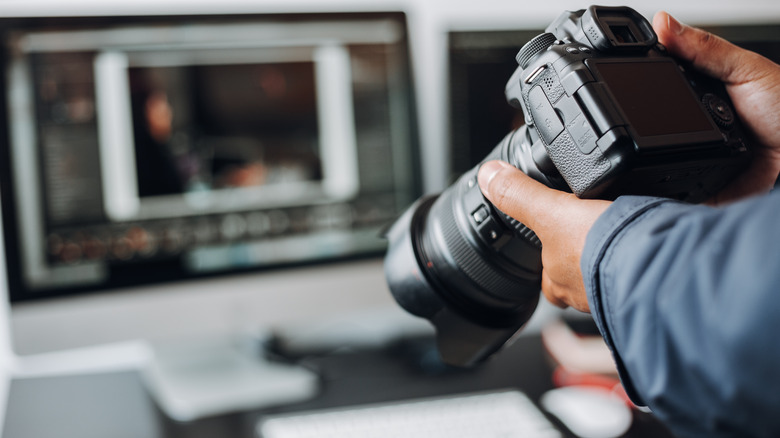
Jorge Mata/Getty Images
From catfishing attempts to the potential for a commercial payday, there are plenty of reasons why unsavory types might want to steal your images. To deter these digital thieves, prevention is your best bet.
Pursuing legal action against a photo thief isn’t easy, and it’s much more difficult to take action after someone deepfakes your photo with AI than it is to avoid the scam in the first place. Even celebrities have had personal photos stolen straight from their devices, so online sharing isn’t the only danger. While you can send a takedown request or sue someone who uses your image without permission, it’s a complicated and — if you go to court — costly process.
When it comes to on-device security, using a passcode or biometric sign-in is crucial to avoid unwanted access. Recognizing common viruses and scams so you can avoid them also helps defend you and your device’s contents. Making your photos difficult to steal is one of the simplest methods of defense to keep them secure. One low-effort method of deterring online image thieves is only posting low-resolution photos so they’re less attractive to scammers.
Alternatively, in addition to using all the security measures your device offers, consider using watermarks on your images. Filing a copyright on a body of published images is another option. Copyrights are more common for professional photographers or those who allow licensing of their images, but if you’re serious about protecting your photos, it’s a helpful tool.
Be picky about cloud storage

Just_super/Getty Images
Not all cloud storage services are made equal, nor are they all cheap. You might have access to a free cloud service via your device or an affiliated account, but it may not be the most secure option.
Security is probably the most important metric, but being picky also means getting the most for your money in terms of support, features, and storage capacity. If you want to pay for more security (and storage space), compare each cloud storage service’s terms and conditions before signing up. You can also look at a provider’s certifications and policies while doing a quick search to see if they’ve ever had a data breach.
For the DIYers out there, building your own cloud storage is also an option, but it also means the responsibility of keeping your images secure is entirely in your hands. In some cases — and depending on your technological prowess — that might be a good thing.
Secure your images with manual locks
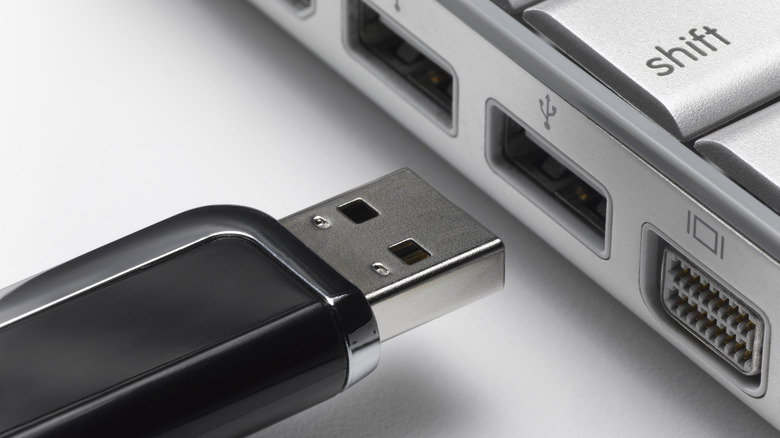
Jeffrey Hamilton/Getty Images
Though film negatives are largely a thing of the past for most smartphone users, the strategy of locking up your photos could still be a smart one, even when they’re on a computer chip rather than in a film canister.
Storing memory cards, USB sticks, or external hard drive storage in a lock box, safe, or even a bank deposit box — if they’re especially valuable — could be the ideal solution to keeping your digital images safe. However, like print photos, hardware can be susceptible to heat, cold, and moisture, so choose your storage location carefully.
Tossing a memory card full of images in a safe is one way to keep your photos protected, but there are more modern ways to secure your photo storage, like a lock on your USB stick. A physical lock on a USB stick prevents unauthorized users from inserting the stick into a device, and many have lock options like a combination code.
Don’t share images publicly
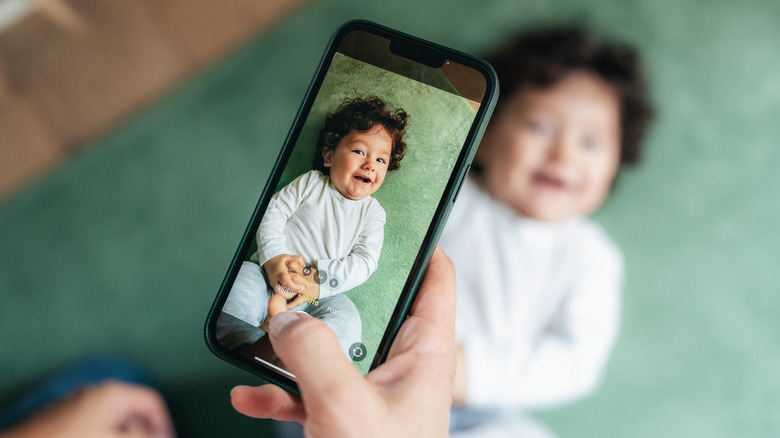
Filadendron/Getty Images
Social media is an amazing tool for sharing images, but do you have any idea who might be downloading your images once they’re online? It could be almost anyone if your profiles are public or you have an extensive friend network.
Paring down your friends list or skipping public shares is a good start for protecting your photos online. Most social media platforms let you lock down your profile and posts to friends only, with some platforms requiring your permission before a person can follow you or interact with posts. Why does this matter? Nearly every social media platform allows users to share others’ posts, including photos, without the original user knowing.
For example, a user can view an Instagram post, then copy the code to embed said post anywhere they want. Instagram notes that you can turn off embeds (from the Instagram app only) without making your profile private, which is another way to protect your images without limiting who can interact with your content. Facebook also permits embedding of any public post, but Meta offers no advice on turning off embeds on the platform while maintaining a public page or profile.
Don’t rely completely on external storage
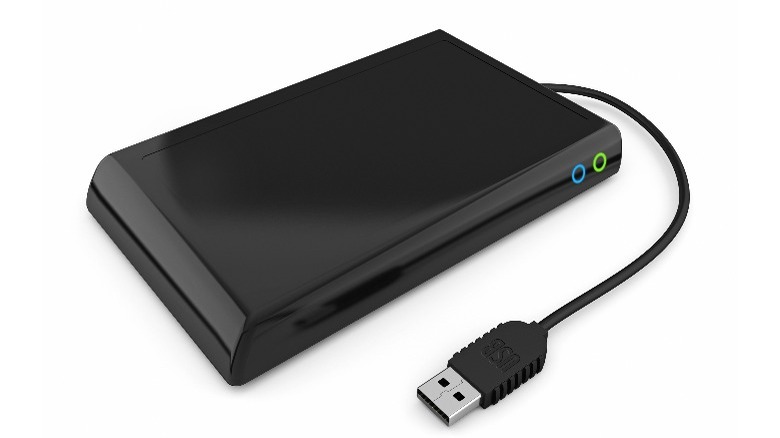
Adventtr/Getty Images
Keeping multiple photo backups is the best way to ensure your images live a long life, but don’t let those external hard drives collect dust for too long. Like other technology, digital storage devices eventually fail, so they’re not foolproof.
A flash drive can last around 10 years or more, but the lifespan depends on device quality and cost. An external hard disk drive may only last three to five years, however. External factors may also compromise the integrity of your device; magnetic fields can damage electronics, moisture causes oxidation, and one drop on a hard surface could mean mechanical failure.
Taking good care of your external storage devices can help extend their life, but keeping a cloud backup ensures double protection for your photos in the event of failure. Plus, who knows when USB drives will eventually go the way of the floppy disk and become obsolete?
Encrypt a photo or folder

UnderhilStudio/Shutterstock
Encryption is one of the simplest ways to keep prying eyes away from your private images. To put it simply, encryption means password protection, but the security goes a bit deeper. Encryption effectively scrambles your data so that even if you send an encrypted image through email and someone intercepts it, they can’t view the file without the appropriate passcode.
You can choose to encrypt images one by one, or deposit them into a folder and encrypt the whole thing. You can even encrypt an entire hard drive to secure all your data at once. For photographs, especially any of a risque variety, encrypting a folder could be a simple solution to image security challenges on a computer.
With smartphones, encryption can be a bit more complicated if you want a layer of protection in addition to lock codes or biometric entry. On most devices, you will need a cloud storage app or a separate encryption app to encrypt your images.
Print your own photos
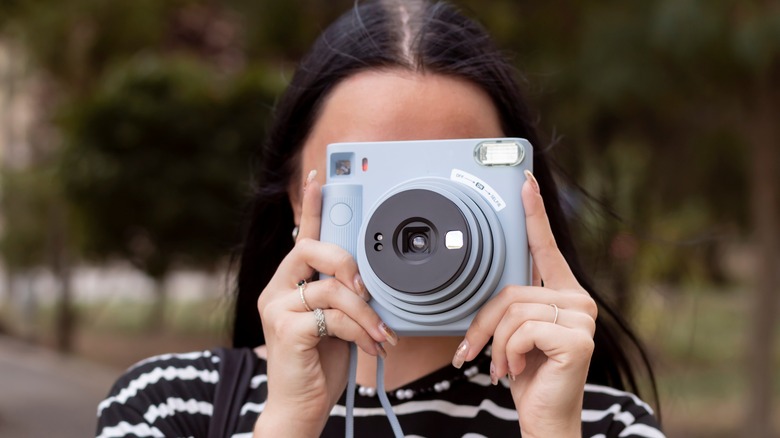
Nataliaphoto2708/Shutterstock
It’s been a while since anyone had to worry about employees in the photo developing department swiping prints since self-serve photo printing is the new trend. Yet photo printing services are still fraught with risk. If you walk into a photo processing center, you’ll still need to connect your device or storage card at a kiosk. Online, you might be uploading images where they are stored — albeit briefly — during processing.
In either case, there are still opportunities for your photos to be seen, swiped, or even lost during transfer. Printing photos at home avoids third-party involvement, and you don’t need an old-school Polaroid to do it. Mobile phone photo printers have your snapshots ready in seconds and don’t involve outside processing. You also can’t argue with the nostalgia of printing a photo moments after you snap the picture if you’re a member of the Polaroid generation.
Be clear about image copyrights

Jlgutierrez/Getty Images
Whether you choose to add watermarks to your images or try another method of deterring would-be thieves, a copyright caption could add another layer of protection. If unsavory types are searching the web for easy-to-steal photos, a simple copyright declaration could mean they keep scrolling.
The good news is that in most countries around the world, copyright protection is immediate and automatic after you take a photograph. Then, it’s as simple as including a copyright notice when you post the image online. Copyright notices should include the word or symbol for copyright, the year of publication, and the owner’s name.
You can even take it a step further and register your photographs with the U.S. Copyright Office for more legal backup. For most social media users, though, a copyright caption might offer enough peace of mind and a starting point if legal action ever becomes necessary.
